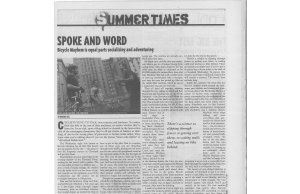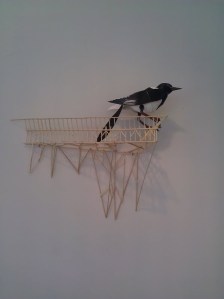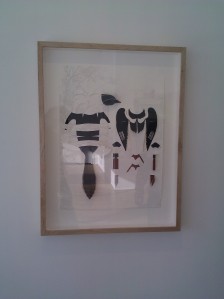note: This appeared originally in the Cleveland Free Times in 2006. The two-wheeled adventure rides known as “Bicycle Mayhem” are a part of history, though we know there’s plenty more mayhem rolling around out there. Don’t hesitate to let me know who you are. I’d love to go on your ride.
SPOKE AND WORD
Nighttime rides were equal parts socializing and adventuring
by Michael Gill
Cyclists tend to talk about injuries and hardware. No matter their day jobs or the cost of their machines, no matter whether they come from the Lycra clad, sport riding school or dress in the beat-cotton chic of the messengers downtown, they’ve all got stories of balance or skidding, of cars in the wrong place, of punctures or broken brake cables. They know what you’re talking about if you use the phrase “down tube shifter” or if you speak of “old school Italian steel.”
The Wednesday night ride known as Bicycle Mayhem has all that. But there’s also an appetite for the city—the quest to ride bikes into the forgotten corners of Cleveland and get into them.
Dan Dominic sits on a stone ledge in the evening shadow of the Terminal Tower, waiting for the week’s ride to gather. The rain has taken a break in a biblical way. After a week of steady soakage, the clouded Erie sky broke to let in a few hours of sun. Just enough sun for optimism, even if the weathermen say the chance for an overnight downpour is 100 percent.
Dan and his brothers Greg and Tom started Bicycle Mayhem a few years ago as a late night romp through empty downtown, with an ad lib itinerary that would detour as needed for beer or to appreciate the gritty attractions. They might go with four people, or they might go with twenty. Back in those days they’d start at 10 p.m. There were visits to empty buildings and dark viaducts, to the tops and underbellies of bridges, to loading docks and court yards.
But these days the Mayhem rollers have to get to day jobs. Dan is a courier, one of those guys you see threading through cross traffic, pissing you off as he sets his own rules with peripheral vision as the supreme judge of who has the right of way. But even he has to wake up in the morning. So now the ride starts at 7:30 p.m. And having toured the city for a couple of years, the event has morphed in another way, too. Usually it starts with a bike polo game in a parking lot, with modified croquet mallets and softballs, followed by a longer ride starting at 9 p.m.
But tonight, for reasons unexplained, it’s old school Bicycle Mayhem, cutting right to the beer chase—first the Barking Spider bar, and then a clandestine visit to a rich man’s grave.
The clock on the Terminal Tower says 8 p.m. When two others roll up—Dan’s brother Greg, and another dude, David Trolio. It seems like everyone is related. Conversation moves right to the accident du jour, which didn’t happen to Dan the courier, but to David’s brother, John, who met a car head-on in Little Italy, opening up a second mouth and breaking a tooth in the process. But that was two weeks ago. The stitches are already out. We’ll meet him later.
All heads turn and the ride gets underway when a guy in a Curious George lycra racing jersey rolls down Superior for the third time on what is estimated to be $10,000 worth of a carbon fiber, time trial bike. Hardware like that is all a cyclist needs to start up a conversation with a stranger, and soon the crew has picked up Alex on the carbon fiver machine, which he says is a brand new toy, just two rides old.
They all head off together, weaving through the city, rolling up Rock and Roll Boulevard and heading east on the North Marginal—the Shoreway and I-90 on the right, Burke Lakefront Airport and the lake itself on the left. They flow around each other in a way that keeps conversation going. On Martin Luther King Boulevard keep to the street because the Harrison Dillard bike way, which runs along next to the road like a sidewalk, is typically glittered with glass. There’s talk of wild dogs in Rockefeller Park, and David has seen a few of them, including the big black shepherd, which he knows he can out sprint. No stray canines show themselves this trip.
Time flies when you’re riding in a pack, and soon they roll around University Circle and reach the destination: pitchers of Great Lakes Brewing Company Holy Moses. Behind the bar at the Barking Spider, the Cavs are winning their playoff game against the Pistons—a three-point lead with two minutes left, and they could pull ahead three games to two in the series. Bicycle Mayhem sits outside. John Trolio meets us at a picnic table. His tooth is missing a jagged triangle, and he’s taking pain killers while a dentist tries to figure out how to proceed. John won’t be drinking.
A pack of cyclists in a bar at night is a curiosity that seems to attract women, and several come to talk while Bicycle Mayhem drinks. One points to a mountain of black clouds rolling in. Another identifies herself as a TV talent scout for something meant to compete with American Idol. She tries to get Bicycle Mayhem to sing. The attempt fails. Four pitchers later, the clouds are still holding their water, and it’s time for the trip to that grave at Lakeview Cemetery.
It’s all locked up at this hour, but there’s a science to slipping through fences or getting over them, to scaling walls and leaving no bike behind. These are secrets you might learn if you’ve got it in you to log a dozen miles in the dark of a Cleveland Wednesday. To anyone who doesn’t, such feats of skill and cooperation will remain a mystery. The breach does not take long.
Inside the cemetery, the trees blot out the city. Asphalt winds around the landscape, past obelisks and statues and granite knock-offs of the Parthenon. Back in a corner, Al Lerner rests, presumably in peace, surrounded by the evidence of the wealth he had in life. You can’t find this in the dark unless you know where you’re going. Somebody says its like Lerner’s own suburban development, landscaped with shrubbery and a walkway.
Bicycle Mayhem never stops talking, and soon everything that surrounds the riders finds itself in their conversation—the extremes of wealth and poverty, the beauty of meticulously cut and symmetrically arranged stone, the fate of the city down below, and the rain which has begun to fall steadily. It’s coming up on midnight, which feels early to the Bicycle Mayhem Crew, and they’re happy to be wrapping it up at such a reasonable hour. Back through the tangled paths, back over the wall, back to civilization they go.
The beauty of rain-slicked blacktop at midnight in Cleveland is that it is nearly empty of cars. Bikes can roll undisturbed, and if the wind is not blowing, and the temperature is high enough, the rain doesn’t matter very much. You’ll get soaked, to be sure. It’s just another reminder that you’re alive. Bicycle Mayhem pairs off according to each rider’s destination, and they begin to pedal home.









